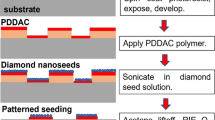Abstract
A three-dimensional phase diagram of carbon has been built in the coordinates “pressure–temperature—dispersivity” on the basis of the published data on detonation-diamond properties. Key words: three-dimensional phase diagram, detonation diamond, nanoscale diamond particles, ultrafine carbon.
Similar content being viewed by others
REFERENCES
F. P. Bundy, W. A. Basset, M. S. Weathers, et al., “The pressure-temperature phase and transformation diagram for carbon; updated through 1994,” Carbon, 34, No. 2, 141–153 (1996).
Chen Quan, Yun Sou Rong, Huang Feng, and Lei Ding Jing, “Study of formation of condensed carbon in detonation by analyzing graphite and diamond crystallites in soot,” in: 11th Int. Detonation Symp., Snowmass, Colorado, U.S.A., Aug. 29–Sept. 4 (1998), pp. 214–215
Yu. F. Komnik, “Causes of nonequilibrium phase emergence in thin films,” Fiz. Tverd. Tela, 10, No. 1, 312–314 (1968).
I. D. Morokhov, L. I. Trusov, and V. N. Lapovok, Physical Phenomena in Ultrafine Media [in Russian], Énergoatomizdat, Moscow (1984), p. 195.
A. I. Bublik and B. Ya. Pines, “Phase transition under thickness changes in thin metal films,” Dokl. Akad. Nauk SSSR, 87, No. 2, 215–218 (1952).
S. B. Viktorov, S. A. Gubin, and I. V. Maklashova, “Thermodynamic calculations of the state diagram of disperse carbon phases,” in: Physical Chemistry of Ultrafine Systems: Proc. of the IV All-Russian Conf., Moscow (1999), pp. 195–196.
S. B. Viktorov, S. A. Gubin, and I. V. Maklashova, “Equations of state for ultrafine graphite and diamond particles,” in: Physical Chemistry of Ultrafine Systems, Proc. of the V All-Russian Conf., Eng.-Phys. Inst., Moscow (2000), pp. 49–50.
Yu. G. Frolov, Course of Colloid Chemistry. Surface Phenomena and Disperse Systems [in Russian] Khimiya, Moscow (1982), p. 83.
I. Yu. Mal'kov, “Formation of the ultrafine diamond phase of carbon at detonation of heterogeneous mixture compositions,” Fiz. Goreniya Vzryva, 27, No. 5, 136–140 (1991).
I. Yu. Mal'kov “Analysis of factors determining efficiency of diamond formation by detonation,” in: Ultrafine Powders, Materials, and Nanostructures [in Russian], State Univ., Krasnoyarsk (1996), pp. 47–48.
S. V. Pershin, E. A. Petrov, and D. N. Tsaplin, “Influence of the molecular structure of explosives on the rate of formation, yield, and properties of ultradisperse diamond,” Combust. Expl. Shock Waves, 30, No. 2, 235–238 (1994).
A. M. Staver, N. V. Gubareva, A. I. Lyamkin, and E. A. Petrov, “Ultrafine diamond powders made by the use of explosion energy,” Combust. Expl. Shock Waves, 20, No. 5, 567–569 (1984).
N. R. Greiner, D. S. Phillips, and J. D. Johnson Fredvolk, “Diamonds in detonation soot,” Nature, 333, 440–442 (1988).
V. F. Anisichkin and I. Yu. Mal'kov, “Thermodynamic stability of ultradispersed diamond phase,” Combust. Expl. Shock Waves, 24, No. 5, 631–632 (1988).
P. Badziag, W. S. Verwoerd, W. P. Ellis, and N. R. Greiner, “Nanometre-sized diamonds are more stable than graphite,” Nature, 343, 244–245 (1990).
Author information
Authors and Affiliations
Rights and permissions
About this article
Cite this article
Vereshchagin, A.L. Phase Diagram of Ultrafine Carbon. Combustion, Explosion, and Shock Waves 38, 358–359 (2002). https://doi.org/10.1023/A:1015618222919
Issue Date:
DOI: https://doi.org/10.1023/A:1015618222919




